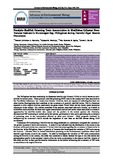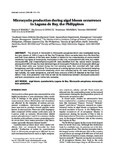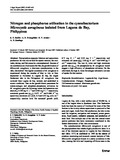Residence time models and Pyrodinium blooms in Matarinao and Murcielagos Bays, Philippines
Share
| dc.contributor.author | Lumayno, Sanny David P. | |
| dc.contributor.author | Benico, Garry | |
| dc.contributor.author | Yñiguez, Aletta | |
| dc.contributor.author | Alabia, Irene D. | |
| dc.contributor.author | Fernandez, Ian Quino D. G. | |
| dc.contributor.author | Dianala, Rex Delsar B. | |
| dc.contributor.author | Azanza, Rhodora | |
| dc.contributor.author | Villanoy, Cesar | |
| dc.coverage.spatial | Matarinao Bay | en |
| dc.coverage.spatial | Murcielagos Bay | en |
| dc.date.accessioned | 2022-03-14T06:38:11Z | |
| dc.date.available | 2022-03-14T06:38:11Z | |
| dc.date.issued | 2022-03 | |
| dc.identifier.citation | Lumayno, S. D. P., Benico, G. A., Yñiguez, A. T., Alabia, I. D., Fernandez, I. Q. D. G., Dianala, R. D. B., Azanza, R. V., & Villanoy, C. L. (2022). Residence time models and Pyrodinium blooms in Matarinao and Murcielagos Bays, Philippines. Philippine Journal of Science, 151(S1), 79–90. | en |
| dc.identifier.issn | 0031-7683 | |
| dc.identifier.uri | http://hdl.handle.net/10862/6296 | |
| dc.description.abstract | This is the first report on hydrodynamic models to determine current and water residence time patterns for Matarinao and Murcielagos bays in the Philippines, which have a long history of harmful algal blooms (HABs). Field surveys were conducted in Matarinao Bay in April and August 2010 and in Murcielagos Bay in February 2011. Hydrodynamic models of the bays were developed, and spatially explicit water residence times were estimated from the models based on rates of concentration decrease of a tracer within the bay. Both bays exhibited two distinct areas – the mouth with faster current flow and low residence time, and the head area with slower current flow and higher residence time. During the southwest monsoon, the residence time at Matarinao Bay was 5 d longer than that during the northeast monsoon. Phytoplankton sampling in both bays confirmed blooms of Pyrodinium bahamense, but the spatial distribution did not consistently correlate with the simulated residence time patterns. While residence time plays a significant role in algal blooms, extraneous factors may also influence the distribution of phytoplankton within embayments. | en |
| dc.language.iso | en | en |
| dc.publisher | Department of Science and Technology | en |
| dc.relation.uri | https://philjournalsci.dost.gov.ph/images/pdf/pjs_pdf/vol151_S1_Marine_Botany/residence_time_models_and_pyrodinium_blooks_.pdf | en |
| dc.subject | harmful algal bloom | en |
| dc.subject | residence time model | en |
| dc.title | Residence time models and Pyrodinium blooms in Matarinao and Murcielagos Bays, Philippines | en |
| dc.type | Article | en |
| dc.citation.volume | 151 | |
| dc.citation.issue | S1 | |
| dc.citation.spage | 79 | |
| dc.citation.epage | 90 | |
| dc.citation.journalTitle | Philippine Journal of Science | en |
| dc.subject.asfa | hydrodynamics | en |
| dc.subject.asfa | phytoplankton | en |
| dc.subject.asfa | plankton blooms | en |
| dc.subject.asfa | bathymetry | en |
| dc.subject.asfa | salinity | en |
| dc.subject.scientificName | Pyrodinium bahamense | en |
Fail dalam item ini
| Fail | Saiz | Format | Lihat |
|---|
Penerbitan ini terdapat dalam koleksi berikut
-
AQD Journal Articles [1223]
These papers were contributed by AQD staff to various national and international journals



